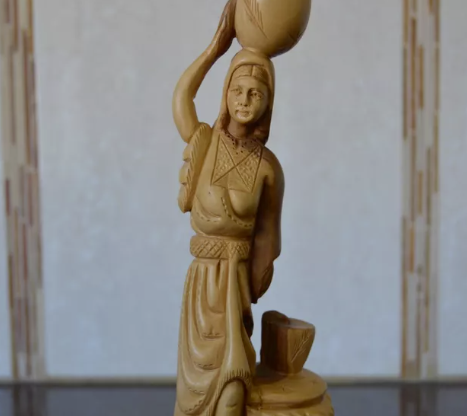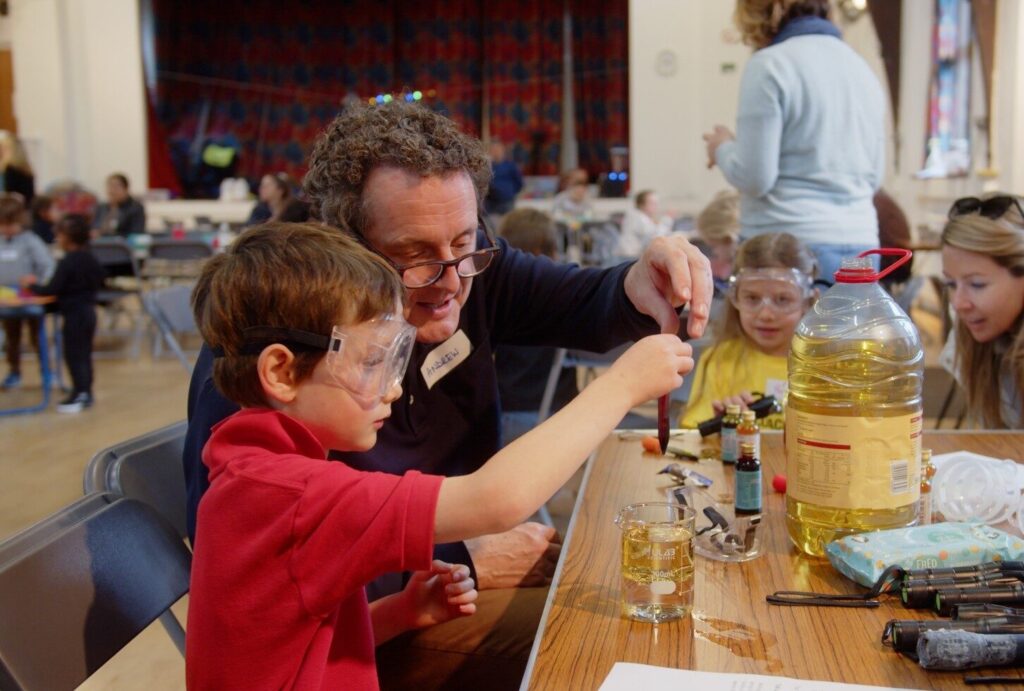What a fantastic time we had – 18-20 of us, regional coordinators and sympathetic friends – gathered together to talk ‘mess’ for 24 hours. It was such fun, such a luxury to be able to concentrate on some of the big issues and to glean each other’s wisdom thereupon. I came away thinking how privileged we are to have such thoughtful, wise and experienced people taking an interest in Messy Church.
Martyn made copious notes, which you can read through below. And eventually we hope to be working through these in greater depth in an online forum. Suffice it to say that I have a very long To Do list as a result of the round table, but will get round to it as soon as is humanly possible.
Messy Church Co-ordinators’ Conference 2009
14 -15 September at Wycliffe Hall, Oxford
A. What’s going on?The coordinators introduced themselves and briefly sketched out how things were going in their Messy Churches, including how long they had been running, some of the good things that were happening, the challenges they were facing and the new directions they are exploring.
1. Messy Church at CowplainPaul (the vicar) told us that they had just celebrated their fifth birthday; the average attendance was between 60 and 70; they have a number of teenage helpers; they were looking into how to bridge the gap between their monthly Messy Churches.
2. Messy Churches in LiverpoolJane L. has links with ten Messy Churches with Anglican and Methodist connections. Jane’s own Messy Church is known as L:19 and it celebrated its first birthday recently with an attendance of 135 people, half of whom were new to church. Jane is in the process of letting go of some of her diocesan work to be ‘more messy’ and her great joy in the work was seeing families being brought together. Her experience was that there were many types of Messy Church, often with variable attendance, and her main challenge was finding the right people to be available to do the pastoral side of the work during their times together. She had run a ‘messy market’ in the village, which had been a great success, and her L19 is also developing a dream group for alternative worship and a reading group. Another challenge was the need to provide crafts for those with special needs.
3. Messy Church in CornwallJanet is responsible for six Messy Churches in her area and is known as the ‘messy lady’! She told us about her Messy Church on the beach and other links to local events such as the scarecrow festival. She is keen to link to Sunday church with a Messy Christingle in December. Attendances vary but are often between 40 and 50 people. Her Messy Churches are very rural and there is a need for more pastoral help during sessions. Two Fresh Expressions worked together (perhaps for the first time) when Messy Church and Surfers Church joined forces for ‘sandcastles against the tide!
4. Messy Church in EdinburghThere is already one Messy Church running in Leith. Reuben had just begun his first Messy Church in a ‘posh area’ (Portabello?) on Saturday. He was aware that people in this area were interested in environmental issues etc. and he was keen to explore in his Messy Church issues that would connect with the culture of this area.
5. Messy Church in ColchesterGill has been running her Messy Church for a year and it had arisen out of the need to re-establish community in that area. Gill has also set up a ‘messy club’ that does not have a meal but does have a cafe area for parents. She sees it as a doorstep into Messy Church proper (though there too parents often still stay on the edge). She is also going to experiment with ‘messy bite’ once a month in which, by invitation, families can go deeper using the resource Multisensory Message – adults and children learning together. For Gill the challenge of Messy Church is to create a new place of belonging, especially for those adult helpers who still feel they belong primarily to traditional church. Relationships are key.
6. Messy Churches in KentGraham has visited a number of Messy Churches in his area to lead the celebrations. He still meets the mindset that Messy Church is only another afterschool event for children.
7. Messy Church in the MidlandsJane B. has worked with a number of Messy Churches in her area and is very interested in how Messy Church is prompting conversations and thinking about what it means to support families on their own faith journey at home and what the relationship between this and Messy Church can be.
8. Messy Church in DronfieldChris told us about her Messy Church, which has been running for three years and grew out of a desire for all-age worship that had to move outside of Sunday. The team studies the Bible together in preparation and they all work together on the theme for each session. Every Messy Church session has a quiet space – space out – linked to the theme and there’s always a ‘loose moose’ table for the very young. The challenge was how to keep older boys involved and they also have a number of people with various special needs. They have worked hard to include crafts with a bias towards those who can’t sit still! Messy Church is helping to create community, including teenagers, and it is vital that Messy Church should always be relational – there should always be time to chat. They are also offering ‘deeper mess’ as an opportunity for further discipleship.
9. Messy Church in HartlepoolMike told us about his Messy Church, which meets on a Sunday – this time slot is most suited to the culture of his area. The food is a great draw and it’s been running for about one year. They use buffet food and most people who come are not from traditional church. The challenge is to create unity in this area and provide good pastoral care during the time of Messy Church. They are looking to provide ways to encourage the craft leaders to engage in conversation with those who come. There was also the problem of parents talking during the worship time and how to focus everyone during the celebration.
10. Messy Church in CanadaAndy and Sue are visiting a number of Fresh Expressions in Britain and come from the Diocese of Niagara. They told us about a few of the small messy churches starting there, often in the context of struggling with all-age worship on a Sunday.
11. Messy Church in ClaygateAndrew told us about his Messy Church that has been running for one year, twice a month since February. Their average attendance is 100; they had surveyed those who come: one third also attended on a Sunday; one third came from other churches; and a final third were not from any other church. He is keen to promote and provide good leadership training and they have developed a simple home-grown discipleship course, which includes training in reaching out and making relationships. There is also a system of family mentoring and praying for each other. They have an email database and keep in regular touch. They have tried take-away sheets but they are cautious about the guilt these might also generate. They are not backward in promoting church on Sunday and Sunday all-age services have significantly developed in their style because of the influence of Messy Church. A special-needs group is being set up and there is some talk of a ‘special-needs Messy Church’.
12. Messy Church in Weston-super-MareThis has been going on for two years and Colin says the whole church is becoming increasingly ‘messy-minded’. They have majored on prayer and this happens every Thursday for the whole team. They have a meal at their planning meetings. Colin told us about the large-scale craft activities for the older boys that also attracted the dads! In order to address the issue of creating relationships in Messy Church, they have tried using Facebook and also a number of the mums come together on a Wednesday morning at the local pub, which is a community centre. Colin is moving to Bradford as a pioneer minister and is pleased that Messy Church already carries on without him and that new converts are part of its running. He’s found a swanney-whistle very helpful in signalling for attention!
13. Other voicesOther contributors to the conference included Richard and Karen from BRF. Karen was keen to pick up on the fact that Messy Church is not a recruiting ground for Sunday but also asked the question as to what happens for relationships in this church in between meetings. Richard emphasised the need to keep things ‘messy’ and that BRF is wanting to hold light to what is developing. He was interested to know what Messy Church might be saying to ‘inherited church’ and he also talked about the challenge of messy discipleship – what will this look like and does it mean meeting more than once a month. He asked for prayer for BRF for its involvement with all this – for wisdom and for finances.
Ann Persson is a trustee of BRF and she shared with us how things are developing at her home church in Thame. She is excited that Messy Church is infinitely adaptable. Their church has taken some steps towards starting a Messy Church, which involved a family overnight camp in the grounds of her house and a footsteps family day ending with a family tea.
Finally, Mike from Fresh Expressions (and working at Wycliffe Hall) sketched in the background to Fresh Expressions and some of the principles behind the new ways of being church. The church in general now is promoting a mixed economy agenda, which includes new expressions and traditional church. Messy Church is part of this groundswell of change. However, Fresh Expressions must become sustainable, be connected, owned and disciple-making. He outlined four challenges: these new churches should be missional; contextual ( responding to the culture and this involved listening and being relevant); educational/formational (this involved having discipleship at their heart). Mike believes that the question of discipleship is key – but what does discipleship mean in the 21st century? (Personally, he favoured a simple ‘rule’ for the family that encourages families to talk together and learn in context. It was so important to accumulate and share wisdom in this area, and here he commended the sharetheguide website), and to be ecclesial – being church in the context of where you are but also being connected to the bigger body of Christ. He urged new churches to partner locally and do discipleship collaboratively. He doubted that all-age discipleship is possible all the time.
He ended by saying that, although all this was very challenging for us, these are minor challenges compare to those faced by the first-century church which nevertheless made such strides in mission and discipleship.
B. Making the most of the messWe all now looked at some of the opportunities that are arising out of Messy Church and we broke into groups for this, looking at topics such as: God-talk; all-age involvement; developing community; pastoral care; worship; growing leaders and encouraging teenagers; discipleship.Key issues arising included the need to keep an outward focus; the need to grow leaders; the importance of service and of keeping relationships at the heart of this church. Another aspect was to keep the mother church in touch. Messy Church is a growing congregation that needs people committed to it and who understand its vision
Feedback from the groups
1. It was difficult to find people confident enough to talk about God naturally. However, any small talk is good and building a relationship is the first step to further talk. Prompt question cards linked to the craft activity sometimes work. A prayer craft station is always popular. But how do we train our teams to talk about God? Photos are sometimes useful in this context and Jane L. uses them in her ‘messy message’. Interestingly, Jane is often excited when the numbers are slightly lower than normal because in large numbers parents easily opt out. She is keen to have families work together, as the hosts or providing the music or running a craft table. It’s important to be all-age in every aspect of Messy Church.
2. All of Messy Church is worship. To have crafts that can be used in the worship as part of the simple liturgy is important. There is the challenge of creating stillness and quiet in the celebration; sometimes subdued lighting can help set the scene. Songs need to be simple but deep such as those from Taize and Iona. Don’t go just for bouncy songs.
3. Mutual acceptance and relational work are at the heart of Messy Church. It must be a place of belonging. Inviting families to take on leadership positions is important; once a month for most people is very regular nowadays. Messy Church provides much more time to get alongside people compared to the short coffee times at the end of traditional church.
4. Messy Church is challenging thinking about what church and worship is. But what is the equivalent of the traditional home groups for Messy Church in between its services? Visiting might be key but maybe coffee groups are better way forward. A Messy Church pub quiz team has been tried.
C. Researching Messy Church
Reuben introduced this topic with some thinking about what it would be helpful to know about Messy Churches in the areas of discipleship, culture, leadership and liminality. Discipleship included faith at home, prayer, quiet corners, community needs, local traditions and celebrations. Culture included reaching all groups including those with disabilities. Leadership included training leaders and issues of non-ordained leadership. Liminality included looking at the importance of Messy Church as an in-between place – something on the edge or threshold of the kingdom.
1. It was felt that is was important to gather stories from Messy Churches.
2. It would be important that we should have some idea of how many of those who come already link to a church and how many come with no previous church background.
3. There was the significance of the venue and whether a church or non-church venue was important for Messy Church and how we help people over that threshold into the kingdom.
4. Gathering the stories about how Messy Church has been adapted in different contexts and ‘exported’ would also be useful.
5. Discipleship: what are people looking for? Who is doing this already? Or what will work for non-church families? How do we help people to want to do it by themselves? How do we broaden our horizons of church? What new meeting times can you find?
6. Culture: the need to gather information on Messy Churches in terms of numbers and leaders. Have some Messy Churches started but not so carried on? If so, why? Do we have attendance profiles? Can we write a questionnaire to help people get started on this? Ann, Colin and Gill already have questionnaires which could be put up as templates on the website.
7. The sacrament: the Messy Church meal is in effect sacramental, but who leads communion and takes baptisms? When is a Messy Church truly recognised as a church? What decides that? How long does it take to get to that point? How can Messy Church structures promote Christian growth? Where does the leadership come from? Have leaders already emerged and what training is happening and on what principles? Are the leaders growing in their faith? Which Messy Churches have ordained leaders at their heart? Does this help or hinder?
D. Supporting and sustaining Messy Church
1. Lucy outlined the possibility of research help coming from Cuddesdon in the areas of Messy Churches in the London area and in deprived areas.
2. Clearly Messy Church is creatively draining and it is easy to lose heart, so we do need a support network. How do we provide regional support? We split up into our regions to look at this. We framed it in terms of local to regional to national support. The website has a key role to play in this, though for example at the moment no one is sending in ideas for the crafts section of the website.
3. Coordinators agreed that they all needed to find out more about what was happening in their areas. They were also aware that other people visited their Messy Churches but they did not often know what happened (if anything) because of it. Also many Messy Churches are not on the directory. Everyone agreed to put some time into finding out more about what was going on in their region and encourage churches to sign up to the website.
4. Lucy suggested another idea a messy craft fair – another sort of liminal Messy Church event, which may be something that could go on tour and help create networks of local messy churches. It was also time to work on something to succeed the Messy Fiestas – maybe a Fiesta Light, which would be in partnership with local regional and diocesan and children’s workers. The following ideas also emerged:
1 To visit more locally and send in stories to Lucy which would go on the website
2 To encourage local questionnaires to be used and then pass these on with the stories, which might then become part of a Messy Church bimonthly newsletter and also provide more resources to put online, along with programme ideas.
3 To gather local funding application templates for a Messy Church news from BRF for leaders and for the website.
4 Regional coordinators to put on informal evenings working with local advisers and to approach local senior church leaders/bishops etc.
5 To set up a forum on the website just for the coordinators to share their thoughts and ideas and Lucy to let them know whenever the website was updated
E. The way ahead
1. Where would Messy Church be in five years’ time? Exponentially it could grow a lot! And how will traditional church respond? Is it just another outreach movement, along with many others? Crystal-ball gazing is a little scary and perhaps staying with a Messy Church ethos of ‘small is beautiful’ is safer and maintaining a light touch on Messy Church should not be lost. Many felt that Messy Church needs to be wary of becoming institutionalised. However, there is need to be praying and to make some sort of sensible planning.
2. How can Messy Church keep its radical edge? What might be the sticking places and the dangers of becoming mainstream? Numbers are not everything! Messy Church needs to keep trying out new things and only create structures that are helpful. Messy Church is a vehicle, not a product. This vehicle needs to change in different contexts, because it is important to keep the living, organic nature of Messy Church. However, others wondered whether Messy Church is just for a season? Or whether it has a prophetic role? We must beware of being confrontational with traditional church and celebrate the mixed economy instead. Messy Churches are complementary, not competitive. It is a both/and and anyway beware of trying to control the Spirit!
3. Openness, adaptability and readiness to change seem to be key elements of Messy Church. It should have loving service at its heart and a desire for more than just a superficial experience of the faith. One surprise with Messy Church is that it is often being led by the non-trained and the non-ordained, but with that comes responsibility of what it really means to be church. We should always aim to be a messy missional church!
4. Lucy urged the group is the sign up to the sharetheguide website, which is a pilot project to keep people in contact with each other and to get our stories out there in the Fresh Expressions arena.
5. There was talk of a Messy Church conference, perhaps over a weekend at a church venue, where people found their own accommodation. This would be for people who have been doing it for a while. However, it was agreed that local networks need to be made to work better first so that we would have a clearer idea as to who would come to this.
6. It was also recognised that, when it comes to discussions on discipleship and community building, there are no single one-size-fits-all solutions. Everyone was at different levels, but time out to reflect on this and have refreshment for the workers was important. Everyone agreed a conference such as this one in Oxford over 24 hours once a year was very important. We would do the same next year and then be in a position to decide whether a bigger conference (and when) would be right.
7. Jane agreed to write up some ideas of what the role of regional coordinators involve.Finally, we shared news about the forthcoming books of Messy Recipes and Messy Crafts (both to be published by Barnabas/BRF in April 2011).
There was so much to talk about!
Messy Church is helping us all to work out more clearly what it means to be church
Messy Church is helping us to work out what it means to be all-age communities
Messy Church is helping us to begin the journey into what discipleship might look like in the 21st century
Oh, and on the Monday evening we all enjoyed hearing from Dave of Infinite Crafts. Many of us now have kits to use and hire out for enamelling or soap making – as well as a few hand-made craft souvenirs of our own!
Martyn Payne September 2009
You may also like

Woman at the Well
3rd Nov 2024
Seaside Sojourn
21st Oct 2024It seems that I always get booked to deliver in-person training at seaside locations. This trend continued last weekend, as I headed off to the coastal village of Seaton, Devon.

Our Survey Said…
7th Oct 2024Back in February 2024, Church of England kindly sponsored a survey, completed by 330 Messy Church leaders. This is what we...

Storytelling from within God’s Story.
10th Sep 2024Hi Messy Friends! My name is Andrew McDonough. I live in Australia, draw sheep and tell stories. It began long long ago w...

